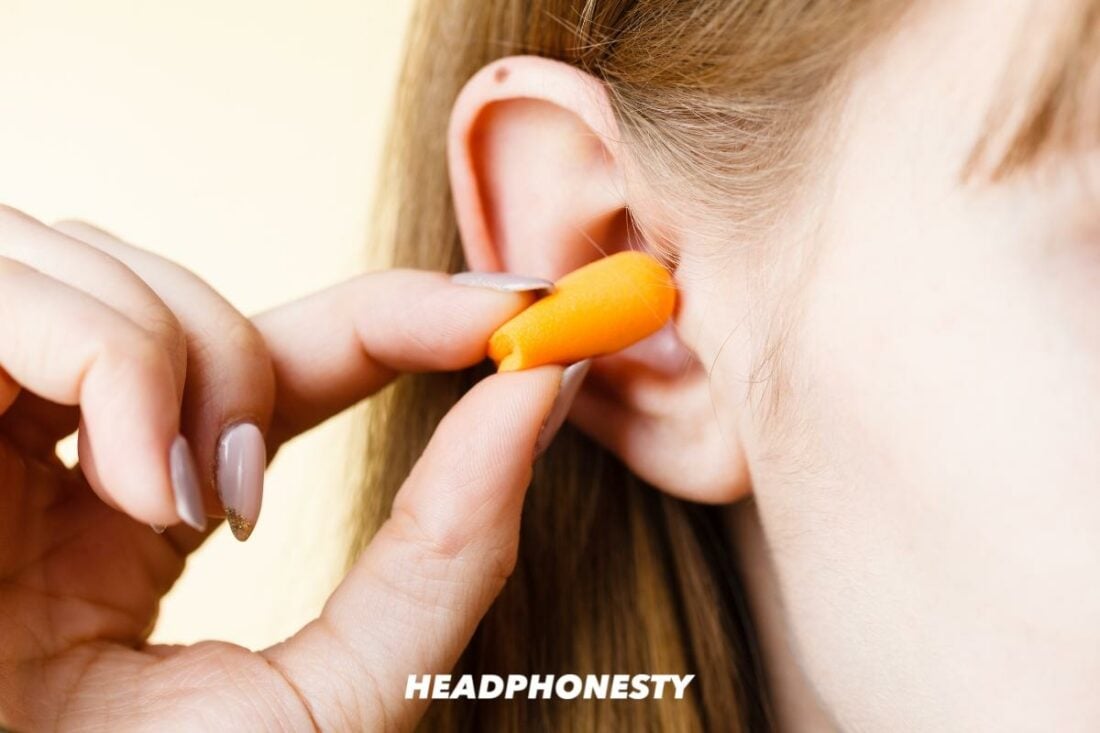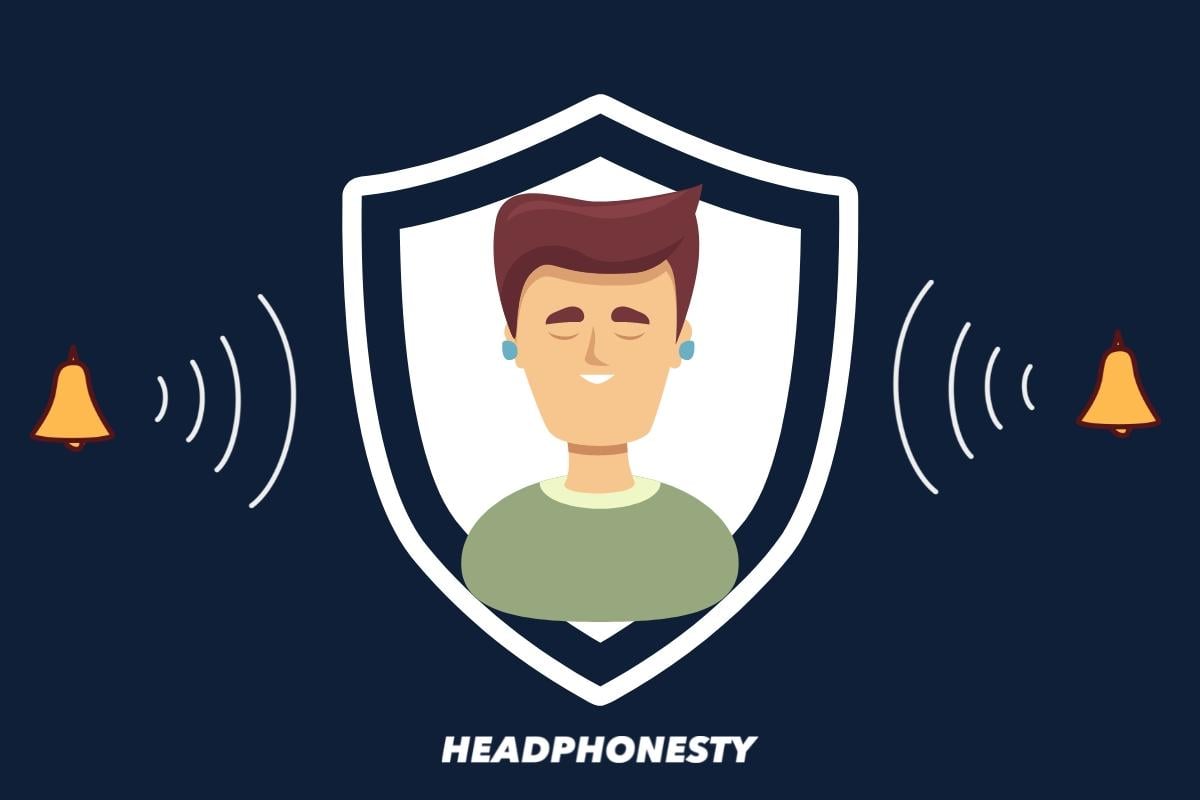Everything you need to know about the noise reduction capacity of earplugs.
Earplugs can help block out irritating ambient noise and protect your ears from dangerous sound levels. In fact, some regulations call for the use of earplugs or other hearing protection in settings where noise levels could endanger workers’ hearing.
However, it’s not always clear how effective earplugs actually are. This can make you feel uncertain when purchasing earplugs, as you don’t know how much they can help you.
But figuring out the noise reduction capabilities of earplugs is quite straightforward if you know where to look and what the information means. We’ll explain all of this in this article, so read on!
How Much Do Earplugs Reduce Noise?
Most properly fitted earplugs reduce sound by 15-30 decibels (dB). This range is determined via the Noise Reduction Rating (NRR).
Yet, there are some, like the Mack’s Maximum Protection Soft Foam Earplugs, that can reduce sound by as much as 33 dB. This is the highest NRR (Noise Reduction Rating) ever recorded for earplugs.
Some other options for earplugs with this top NRR are the Moldex Pura-Fit Earplugs and HEAROS Xtreme Foam Earplugs.
However, the earplugs’ NRR isn’t always accurate.
This is because the testing is done in a controlled environment, so there is a gap between the NRR of the earplugs and their real-world application.
To counter this problem, you can apply a process called ‘derating’ for a more realistic NRR.
While different organizations use different methods for derating hearing protection devices, both OSHA and NIOSH recommend cutting the NRR of your earplugs in half.
This means, if you apply this process to the top-rated earplugs with a 33 dB NRR, they will only be able to reduce sound by around 16 dB.
But while your earplugs’ NRR determines how much protection they provide, it’s not the only factor. The earplugs’ NRR, whether derated or not, is also affected by the following:
How well the earplugs fit

Earplugs work by blocking your ear canal, forcing the sound to pass through the material to enter your ears. This dampens the noise as the vibrations of the sound waves are reduced.
Earplugs must fit snugly in your ear canal to work at full capacity. If they’re too loose, the sound waves can bypass the earplugs and enter your ears. This will reduce their noise reduction capacity significantly.
Earplugs type
The material and type of your earplugs can also affect their performance. The density of the material can change how much they dampen sound and how well they fit. Additionally, a more malleable material will adapt better to your ear canals.
Here are the different kinds of earplugs and their characteristics:
- Foam earplugs: Because they are soft and formable, foam earplugs expand inside your ear canals to fit you well. These earplugs are usually the most effective at noise reduction when properly inserted. However, they are typically single-use, and you should always wash your hands before handling them to prevent infection.
- Pre-molded earplugs: Unlike foam earplugs, pre-molded earplugs come in a set and non-malleable shape. They are usually made from rubber or silicone, so they’re reusable. However, because they’re made from a harder material, they don’t conform to your ears that well. You might have to experiment with different sizes to find a pair that fit you properly.
- Moldable earplugs: Moldable earplugs come in the form of wax or silicone putty that you push into your ear. This means they are entirely adaptable, as they have no set form. They do take some preparation, as you need to warm up the putty to make it workable enough to mold to the shape of your ear canal.
- Filtered earplugs: These earplugs are best suited for flights, concert-goers, or musicians. They contain small filters that slow down the air pressure shift you often experience on an airplane, as well as lower the attenuation of the earplugs for clear but quieter sound.
How to Know How Much NRR You Need
You might think that the amount of NRR you need depends solely on the volume of the noise you want to block out. While that’s partly true, you also need to consider how long you’ll be exposed to the dangerous sound levels.
For example, you’ll be safe at 85 dB for up to eight hours a day. However, if the sound is at 100 dB, you’re at risk after only 15 minutes.
This means you don’t always need to buy high-NRR earplugs if you aren’t exposed to loud noises for a long time.
For example, if you’re using a machine at 100 dB for half an hour, you’ll only need to reduce the volume to around 90 dB to be safe. 10 dB of noise reduction is within the capabilities of plenty of derated earplugs.
But while you might not technically need it, your goal should always be below 80 dB when possible.
For a better idea, here are some common sources of noise and their decibel level:
| Source of Noise | Decibel Level (dB) | Risks after repeated exposure |
|---|---|---|
| The quietest sound a healthy human ear can hear | 0 | No risk of hearing damage |
| Normal breathing | 10 | No risk of hearing damage |
| Ticking watch or clock, rustling leaves | 20 | No risk of hearing damage |
| Soft whispers | 30 | No risk of hearing damage |
| The hum of a refrigerator, a quiet library | 40 | No risk of hearing damage |
| Normal conversations, air conditioning, heavy rainfall | 60 | No risk of hearing damage |
| Washing machine or dishwasher, vacuum cleaner, shower | 70 | You might find this level irritating, but not damaging |
| City traffic from inside a car, alarm clock, toilet flush, noisy resteraunt | 80-85 | You might find this level extremely irritating, but the noise is inconsistent so there is little risk of hearing damage |
| Gas-powered lawnmowers and leafblowers, hairdryer, kitchen blender | 80-85 | Potential damage to your hearing after two hours of exposure |
| Motorcycles, forklifts, electric drill | 95 | Potential damage after about 50 minutes |
| Approaching subway train, car horn at 16 feet (5 meters), busy sporting events, snowmobiles | 100 | Potential hearing loss after 15 minutes |
| The maximum volume level for personal listening devices, a very loud radio, stereo, or television, loud entertainment venues | 105-110 | Potential hearing loss after five minutes |
| Shouting or barking into your ear, power saw, jackhammer, symphony orchestra | 110 | Potential hearing loss in less than two minutes |
| Close sirens or alarms, chainsaws, thunder, oxygen torches, aircraft takeoff | 120 | Pain and injury to the ears |
| Firecrackers, auto racing, jet engines, gun shots | 140-150 | Pain and injury to the ears |
What to Do When Earplugs Aren’t Enough
If the noise exposure is too high for your earplugs to be enough, then you can try dual hearing protection.
Dual hearing protection is when you wear two types of hearing protection simultaneously. Typically, this involves wearing both earplugs and earmuffs.
This helps increase protection by doubling up the material blocking the sound and offering two different fits to give you a better chance of a perfect seal.
How much noise does dual hearing protection reduce?
Doubling up on your hearing protection won’t offer as much protection as you might think.
To calculate your protection level, you can’t simply add the NRR of the two hearing protection devices together. Instead, OSHA has come up with a calculation you can follow:
- Determine the volume of the noise exposure in dB.
- Find which hearing protection device has the highest NRR. Subtract seven from this number.
- Add five to the resulting field-adjusted NRR to account for the second hearing protection device.
- Subtract this number from the dB of noise exposure. The resulting number will be the volume of sound you’re exposed to while using the dual hearing protection.
For example, you are exposed to 110 dB of noise for eight hours at work. You have earplugs with an NRR of 32 dB, which is not enough to keep you safe when derated. You have earmuffs with an NRR of 18 dB.
- You are exposed to 110 dB of noise.
- The earplugs have the highest NRR of 32 dB. Subtract seven from this number to get a field-adjusted NRR of twenty-five.
- Add five to this number to account for the earmuffs. This gives you a total NRR of 30 dB.
- 110 take 30 is 80. This means that when using this dual hearing protection, you will be exposed to 80 dB of noise, which is within the safe range.
Conclusion
Now you know how to figure out the noise reduction of earplugs and when you need to use them. Your hearing should be safe in every situation!
Did you find our article helpful? Were you surprised by how easy it can be to damage your hearing? Make sure to tell us in the comments below.

I don’t know what decibels the stereo played at my gym accounts for yet while not loud it is annoying. I have worn foam ear plugs but they he ave the tendency to loose shape and push out of ear canal.Would dual use ear protection help?